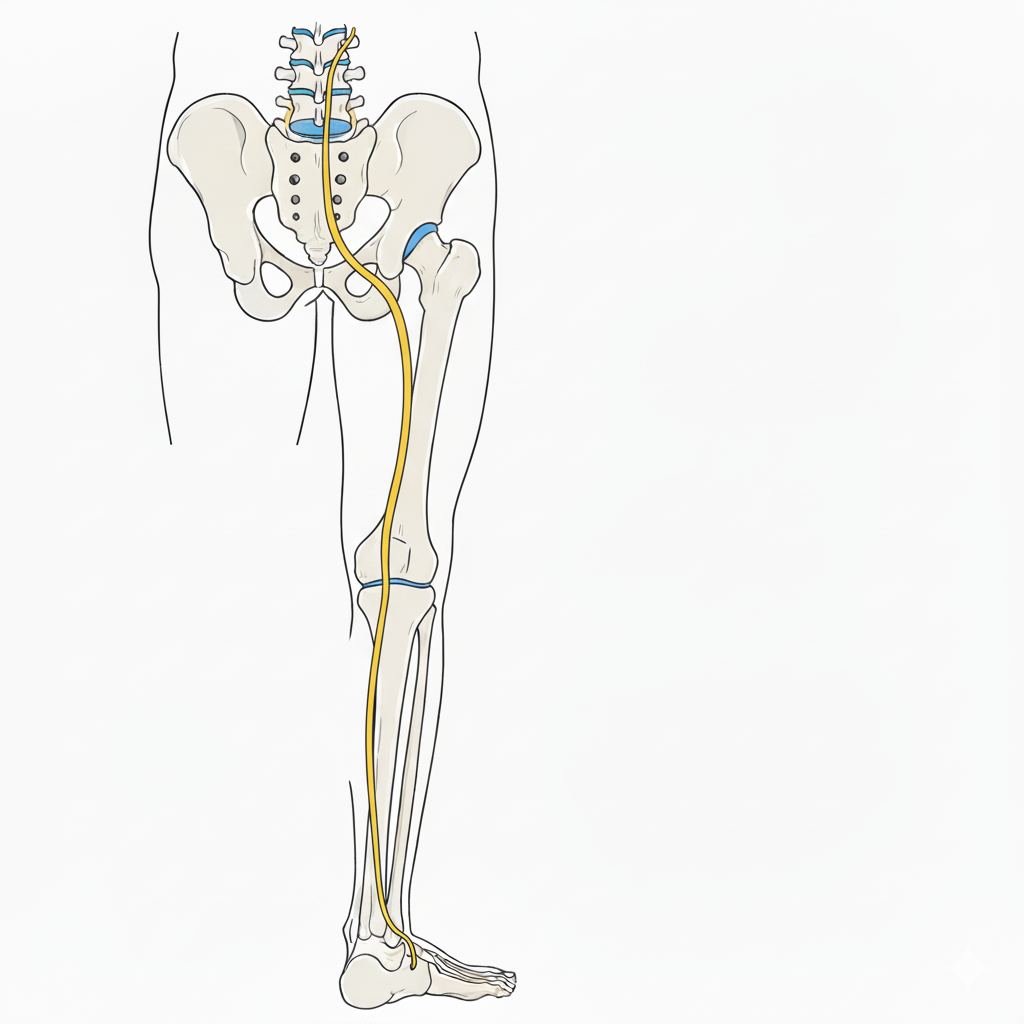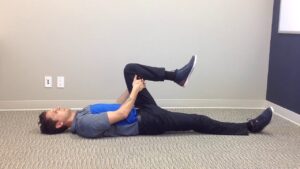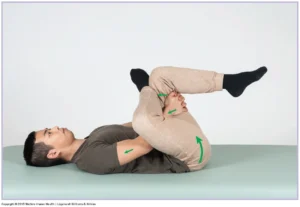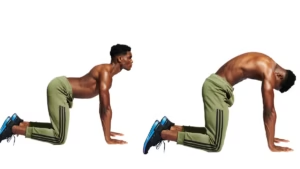That sharp, shooting pain that travels from your lower back, through your hip, and down your leg can be more than just an annoyance—it can be debilitating. One minute you’re fine, and the next, it feels like an electric shock or a hot poker is tracing a path down your body. If this sounds familiar, you’ve likely met sciatica.
It’s one of the most common complaints we see as physiotherapists, and it’s also one of the most misunderstood. Many people think they just have to “live with it,” but that couldn’t be further from the truth.
This guide is here to be your first step toward lasting sciatica pain relief. We’ll break down what sciatica really is, debunk some common myths, and walk you through five simple, effective exercises you can start doing today to calm that angry nerve and reclaim your comfort.
What Exactly Is Sciatica? (And What It’s Not)
First things first: Sciatica isn’t a disease or a diagnosis in itself. Think of it as your body’s very own “check engine” light. It’s a symptom that tells you something is irritating or compressing your sciatic nerve.
The sciatic nerve is the longest and thickest nerve in your body, running from your lower back, through your buttocks, and down the back of each leg. When something along this path puts pressure on it, the nerve sends out those painful signals.
Imagine a garden hose. If you put a kink in it, the water can’t flow properly. Sciatica is similar—something is “kinking” the nerve. The most common culprits are:
- A Herniated Disc: The soft, gel-like center of a spinal disc pushes out and presses on the nerve root.
- Spinal Stenosis: A narrowing of the spinal canal, which can put pressure on the nerve.
- Piriformis Syndrome: The piriformis muscle, located deep in your buttock, can spasm or tighten and compress the sciatic nerve.
- Spondylolisthesis: A condition where one vertebra slips forward over another one.
The goal of physiotherapy isn’t just to manage the pain; it’s to find the “kink” and fix it.

The 5 Best Physiotherapy Exercises for Sciatica Pain Relief
Before you start, a golden rule: Listen to your body. These exercises should feel like a gentle stretch, not a sharp pain. If any movement significantly increases your pain or causes new symptoms like tingling or numbness, stop immediately and consult a professional.
1. The Knee-to-Chest Stretch
This is a fantastic starting point to gently release tension in your lower back and gluteal muscles, giving the sciatic nerve a little more room to breathe.

- How to do it:
- Lie on your back on a comfortable, firm surface with your knees bent and feet flat on the floor.
- Gently bring one knee up towards your chest, clasping your hands around the back of your thigh or just below your knee.
- Slowly pull the knee closer to your chest until you feel a comfortable stretch in your lower back and buttock.
- Hold this position for 20-30 seconds, breathing deeply and evenly.
- Slowly release and lower your leg back to the starting position.
- Repeat 3 times on each side.
- Why it helps: It reduces nerve compression by gently stretching the lumbar spine and hamstring muscles.
- Pro-Tip: Don’t pull on your kneecap! Keep your hands on your shin or thigh to protect the knee joint.
2. The Lying Piriformis Stretch
If your sciatica is caused by a tight piriformis muscle (a common issue for desk workers!), this stretch is your new best friend.

- How to do it:
- Lie on your back with both knees bent and feet flat on the floor.
- Cross the ankle of your painful leg over the opposite knee, creating a “figure 4” shape.
- Slowly lift the bottom foot off the floor.
- Reach through the opening of your legs and interlace your fingers behind the thigh of the bottom leg.
- Gently pull that leg toward you until you feel a deep stretch in the buttock of your crossed leg.
- Hold for 30 seconds, breathing deeply.
- Repeat 2-3 times on the affected side.
- Why it helps: It directly targets and lengthens the piriformis muscle, relieving pressure on the sciatic nerve that runs underneath it.
- Pro-Tip: Keep your head and shoulders relaxed on the floor. If you’re straining your neck, you’re pulling too hard.
3. The Seated Spinal Twist
A gentle twist can help create space in your spine and improve mobility, which is crucial for relieving nerve pressure.
- How to do it:
- Sit on the floor with your legs extended straight out in front of you.
- Bend your right knee and place your right foot on the outside of your left thigh.
- Place your right hand on the floor behind you for support.
- Place your left elbow on the outside of your right knee and use it to gently twist your upper body to the right.
- Look over your right shoulder and hold the stretch for 20-30 seconds. You should feel a stretch in your lower back and hip.
- Slowly unwind and repeat on the other side.
- Why it helps: This stretch improves spinal mobility and can help relieve pressure caused by spinal stenosis.
- Pro-Tip: Sit tall! Imagine a string pulling the crown of your head toward the ceiling to avoid slumping.
4. The Cat-Cow Stretch
This classic yoga pose is excellent for mobilizing the spine in a safe, controlled way. It encourages blood flow and reduces stiffness in the lower back.

- How to do it:
- Start on your hands and knees in a tabletop position, with your wrists under your shoulders and your knees under your hips.
- Cow Pose: Inhale as you drop your belly towards the floor, lift your chest and chin, and look up. Arch your back gently.
- Cat Pose: Exhale as you press into your hands, round your spine up towards the ceiling (like an angry cat), and tuck your chin to your chest.
- Flow smoothly between these two poses for 10-15 repetitions.
- Why it helps: It improves the flexibility of the lumbar spine and pelvis, which helps decompress the nerve roots.
- Pro-Tip: Let your breath guide the movement. The motion should be slow and deliberate, not rushed.
5. Glute Bridges
Strengthening the muscles that support your spine is just as important as stretching them. Glute bridges activate your glutes and hamstrings without putting strain on your back.
- How to do it:
- Lie on your back with your knees bent, feet flat on the floor hip-width apart, and your arms by your sides with palms down.
- Engage your core and squeeze your glutes.
- Lift your hips off the floor until your body forms a straight line from your shoulders to your knees.
- Hold at the top for 3-5 seconds, keeping your glutes squeezed.
- Slowly lower your hips back to the floor.
- Repeat for 10-12 repetitions.
- Why it helps: Strong glutes provide better support for the lower back, reducing the strain that can lead to nerve irritation.
- Pro-Tip: Don’t over-arch your back at the top. The work should come from your glutes, not your spine.
Myth vs. Fact: Debunking Sciatica Misconceptions
Let’s clear up some common myths that might be holding back your recovery.
- Myth: You must stay in bed and rest completely.
- Fact: While you should avoid activities that aggravate the pain, prolonged bed rest can make things worse. Gentle movement and stretching, like the exercises above, are essential for recovery.
- Myth: Sciatica is permanent and I’ll need surgery.
- Fact: The vast majority of sciatica cases can be resolved with conservative treatments like physiotherapy, exercise, and lifestyle modifications. Surgery is typically a last resort.
- Myth: Painkillers are the only way to manage sciatica.
- Fact: Medication can help manage acute pain, but it doesn’t address the root cause. Physiotherapy aims to fix the underlying mechanical issue for long-term relief.
When Should You See a Physiotherapist?
While these exercises are a great starting point, sciatica can be complex. You should seek professional guidance if:
- The pain is severe or isn’t improving after a week of gentle stretching.
- You experience worsening numbness, tingling, or weakness in your leg.
- The pain started after a traumatic injury.
- (Red Flag – Seek Immediate Medical Attention) You experience loss of bladder or bowel control.
A physiotherapist can provide an accurate diagnosis, create a personalized treatment plan with manual therapy and targeted exercises, and help you get back to living pain-free.
Your Actionable Checklist for Today
- Try one stretch: Pick the Knee-to-Chest stretch and do it right now. Feel that gentle release?
- Check your posture: Are you slumping as you read this? Sit up tall, pull your shoulder blades back, and untuck your chin.
- Set a movement alarm: If you have a desk job, set a reminder to get up and walk around for 2 minutes every hour.
Conclusion: Take the First Step Towards Relief
Sciatica can feel overwhelming, but remember that you have the power to take control. By understanding the root cause and incorporating gentle, targeted movements into your day, you can effectively manage and often eliminate that nagging nerve pain.
Start with these five exercises, be consistent, and listen to your body’s feedback. Small, consistent efforts are the key to long-term sciatica pain relief.
Ready for a personalized plan to kick sciatica to the curb for good? Our team of expert physiotherapists at Physiogain.com is here to help.
Physiogain and let’s create your roadmap to a pain-free life. Your spine will thank you!
Which of these stretches felt the best for you? Share your experience in the comments below!
Save this post for later and share it with a friend who might be struggling with back pain!